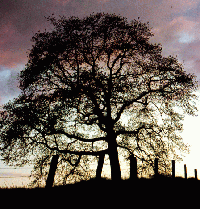Healing power of ancient trees is not mere legend
In the Russian city of Penza there is a pathway that locals call “a health path”. On the path there is a 300-year-old oak that is said to be miraculous. The tree became incredibly popular among the local population after it helped a woman from the city, Nina Sizova. During WWII, Nina’s father was fighting German invaders, and at very beginning of the war the woman got a letter saying that after one battle her father went missing. It meant that Nina would never see the father again. In that epoch, the belief in God was not very popular among the youth, and Nina never believed that she could pray God and ask for help. Some of her acquaintances said she could go to the old oak and share the sorrow with it and then ask for help. It was believed that the tree could really help. The woman came to the old oak to share her sorrow with the tree and asked it to help her.

The young woman found the tree in the forest near the city, embraced its huge trunk, clung to the oak bark and prayed for her father’s rescue. In two weeks after Nina was to the forest, a postman brought a letter from her father. He wrote that after a savage fighting he had his legs terribly wounded, crawled to the coppice nearby and lost conscience. Some people found the wounded soldier in several days and took him to a hospital. Later, Nina learnt that the people found her father right on the day when she came to the oak and asked for help. Since that time, the young woman always came to the old oak regularly seeking help in solution of her problems. Every time she touched the oak bark she felt her problems were no longer burning and left the forest relieved of her sorrows. Nina believed that the tree could help her solve any problems. Indeed, Nina says that all problems in her life were easily solved and she had little trouble since she visited the old oak for the first time.
Since that miraculous rescue of Nina’s father that was believed to be thanks to the 300-year-old oak, the tree became very popular among locals seeking solution of their problems.
Young boy Vadim Kabanov learnt about the miraculous tree from his grandmother, Nina Sizova, the woman who made the tree incredibly popular during WWII. Once, being already a young man Vadim decided to ask the old oak for help when he had troubles in love. “I asked the oak to bring back my girl who abandoned me some time before. I was asking for help but slightly believed that something could be done to help me with my love. When I went home after visiting the ancient tree I felt happy and at ease. In a week my beloved called me and we were together again. I am still sure that it was the old oak that made me happy in love again,” Vadim tells his story.
After several visits to the old “wise tree” Vadim told his friends about its amazing qualities. And they also asked the tree for help. Some people asked the oak to help their relatives recover from illness and others told they were dreaming about a good job or needed solution of their love problems. Even in winter people make a way through the snow to the old oak as they need its amazing power.
Local lore expert Ivan Kovalenko from Crimea says that almost all nations and cultures of the world worshipped trees. Aboriginal tribes of Russia’s Crimea worshipped entire sacred groves and some separate trees. Tatars of Crimea considered the Govorovsky oak tree sacred and used its leaves and bark as a medicine against many diseases. Locals living in the settlement of Gurzuf in Russia’s Black Sea coast know a legend about an old oak standing on Ayudag mountain (the Bear Mountain) known for its healing qualities. Even poets dedicated their poems to the amazing tree. Ivan Kovalenko says that neither religion nor historical upheavals that occurred in Crimea could exterminate worshipping of sacred oaks among people of Crimea.
It is up to each of us if to believe in the healing power of ancient trees or not, if worship them or not. However, for many people it is easier to live when they believe that there is something that may help solve their problems.
Oksana Anikina
Translated by Maria Gousseva
Discuss this article on Pravda.Ru English Forum
Subscribe to Pravda.Ru Telegram channel, Facebook, RSS!


